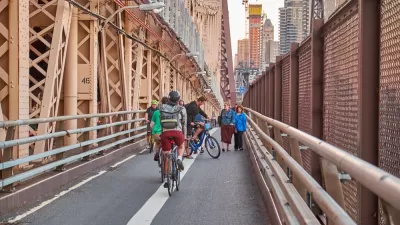Advocates want to see a safer plan for the proposed two-way path on one of the country's busiest commuter corridors.

The bike path proposed for the Brooklyn Bridge by New York Department of Transportation (NYDOT) engineers, writes Alissa Walker in Curbed, is "four feet wide in each direction, which is just barely enough for two pairs of handlebars abreast." And while "any dedicated bike path on the bridge that’s clawed back from traffic is a big improvement," Walker writes that the NYDOT's plan "is not nearly ambitious enough for a crossing on what’s arguably one of the most famous bridges in the world in a city with the largest bike-share system outside of China." NACTO's urban bikeway design guide recommends a 12-foot width for two-way cycleways, and the "convoluted meander of connecting paths at either side of the bridge" creates "a reliable recipe for collisions and crashes."
After adding 28 miles of bikeways in the city over the past year, the half-hearted Brooklyn Bridge design just doesn't "add up," writes Walker. "In an alternate timeline, the city would have widened the promenade so people on bikes got fresh air and skyline views instead of being condemned to the car cage below. But even with an imperfect path, the bridge is certain to get even more riders." Hopefully, Walker notes, the influx of commuters will convince the city to install a wider, safer bikeway in the future.
FULL STORY: The Brooklyn Bridge Finally Gets Its Own Bike Path! Except …

Maui's Vacation Rental Debate Turns Ugly
Verbal attacks, misinformation campaigns and fistfights plague a high-stakes debate to convert thousands of vacation rentals into long-term housing.

Planetizen Federal Action Tracker
A weekly monitor of how Trump’s orders and actions are impacting planners and planning in America.

In Urban Planning, AI Prompting Could be the New Design Thinking
Creativity has long been key to great urban design. What if we see AI as our new creative partner?

King County Supportive Housing Program Offers Hope for Unhoused Residents
The county is taking a ‘Housing First’ approach that prioritizes getting people into housing, then offering wraparound supportive services.

Researchers Use AI to Get Clearer Picture of US Housing
Analysts are using artificial intelligence to supercharge their research by allowing them to comb through data faster. Though these AI tools can be error prone, they save time and housing researchers are optimistic about the future.

Making Shared Micromobility More Inclusive
Cities and shared mobility system operators can do more to include people with disabilities in planning and operations, per a new report.
Urban Design for Planners 1: Software Tools
This six-course series explores essential urban design concepts using open source software and equips planners with the tools they need to participate fully in the urban design process.
Planning for Universal Design
Learn the tools for implementing Universal Design in planning regulations.
planning NEXT
Appalachian Highlands Housing Partners
Gallatin County Department of Planning & Community Development
Mpact (founded as Rail~Volution)
City of Camden Redevelopment Agency
City of Astoria
City of Portland
City of Laramie





























